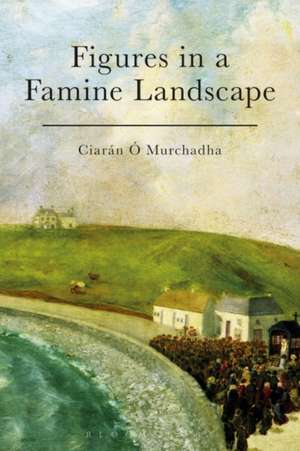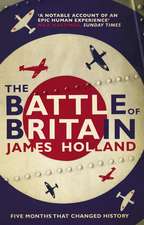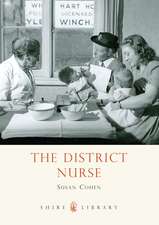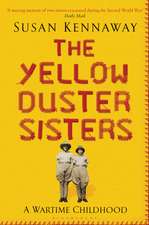Figures in a Famine Landscape
Autor Dr Ciarán Ó Murchadhaen Limba Engleză Paperback – 7 sep 2016
| Toate formatele și edițiile | Preț | Express |
|---|---|---|
| Paperback (1) | 179.10 lei 3-5 săpt. | |
| Bloomsbury Publishing – 7 sep 2016 | 179.10 lei 3-5 săpt. | |
| Hardback (1) | 715.19 lei 6-8 săpt. | |
| Bloomsbury Publishing – 7 sep 2016 | 715.19 lei 6-8 săpt. |
Preț: 179.10 lei
Preț vechi: 207.80 lei
-14% Nou
Puncte Express: 269
Preț estimativ în valută:
34.27€ • 35.78$ • 28.36£
34.27€ • 35.78$ • 28.36£
Carte disponibilă
Livrare economică 14-28 martie
Preluare comenzi: 021 569.72.76
Specificații
ISBN-13: 9781472511553
ISBN-10: 1472511557
Pagini: 240
Ilustrații: 10
Dimensiuni: 156 x 234 x 14 mm
Greutate: 0.36 kg
Editura: Bloomsbury Publishing
Colecția Bloomsbury Academic
Locul publicării:London, United Kingdom
ISBN-10: 1472511557
Pagini: 240
Ilustrații: 10
Dimensiuni: 156 x 234 x 14 mm
Greutate: 0.36 kg
Editura: Bloomsbury Publishing
Colecția Bloomsbury Academic
Locul publicării:London, United Kingdom
Caracteristici
Incorporates a wide range of source materials, such as diaries, newspapers, letters and parliamentary reports
Notă biografică
Ciarán Ó Murchadha is an independent scholar and leading historian of Ireland's Great Famine. He is the author of the internationally acclaimed The Great Famine: Ireland's Agony 1845-1852 (2011).
Cuprins
List of IllustrationsPrefaceMapsIntroduction1. Hurricane from the South West: John Busteed Knox2. Intrepid Fire-Eater:Captain Edmond Wynne3. The Poor Man's Magistrate: John Singleton4. The Medical Gentleman: Patrick Maxwell Cullinan5. The Reverend Sinecurist:Henry Murphy6. The Exterminator General: Marcus Keane of Beech Park7. Father Michael Meehan and the Little Ark8. The Cabin Tumbling Warrior: Crofton Moore Vandeleur9. The Most Charitable Officer: Captain A.E. Kennedy10. The Famine LandscapeNotesBibliographyIndex
Recenzii
[A]n in-depth study of the Great Famine in an area of County Clare, focusing on the role of particular individuals such as clergymen, landlords and newspapermen.
Figures in a Famine Landscape follows nine very different individuals through Ireland's Great Famine of 1845-51. Among them are a Board of Works inspector indifferent to the suffering of the 'perverse creatures' seeking employment on ill-conceived government relief schemes; a money-grubbing doctor who saw financial opportunity in starvation and disease; and a Tory newspaperman shocked by the horror unfolding around him. Most memorable are a land-agent whose gang of drunken 'wreckers' tore down the homes of thousands of smallholders, and his nemesis, a country priest, tending to the hungry and disease-ravaged crowds turned out onto the roadsides by the 'Exterminator General'. Yet there are few simple villains and heroes in Ciarán Ó Murchadha's thoughtful and moving book, but rather complex characters vividly sketched by an accomplished historian.
Figures in a Famine Landscape is a study of the lives of nine men, who either knew each other, or of each other. Ó Murchadha's extensive research provides a new understanding of their roles, or in his words a 'human credibility', that does not always conform with previous views. His exploration of the lives of the less well-known men is an incredible work of historical recovery. Fittingly also, the landscape itself plays an important part in explaining the devastation that visited this county. [The book] not only adds to our understanding of the Great Famine in County Clare, it also provides a model for other micro-studies. It is the work of an accomplished historian who has mastery of his topic and his locality. It is essential famine reading.
Ciarán Ó Murchadha's high reputation as a distinguished historian of the Great Irish Famine is further enhanced by this important reconstruction--based on diaries and other invaluable archival materials--of the lives of nine people in Famine-stricken Clare. One of the counties most devastated by Famine deaths and evictions, it is not surprising that at least six of the protagonists in the book --John Busteed Knox, Captain Edmond Wynne, Marcus Keane, Father Michael Meehan, Crofton Moore Vandeleur and Captain A.E. Kennedy--are known in the national literature. Exceptions are the self- aggrandising medic Cullinan, the incurious Church of Ireland careerist Murphy and the sophisticated landlord/magistrate Singleton. But here Ó Murchadha , in an exhaustive and enthralling piece of writing, illuminates many aspects of their attitudes and behaviours during these turbulent Famine years. His intimate knowledge of the townlands and mid- 19th century gentry and middle-class families of Co. Clare brilliantly contextualises these lives. It is a tour-de-force of good writing and research with a wonderful evocative conclusion on the Famine landscape.
Figures in a Famine Landscape follows nine very different individuals through Ireland's Great Famine of 1845-51. Among them are a Board of Works inspector indifferent to the suffering of the 'perverse creatures' seeking employment on ill-conceived government relief schemes; a money-grubbing doctor who saw financial opportunity in starvation and disease; and a Tory newspaperman shocked by the horror unfolding around him. Most memorable are a land-agent whose gang of drunken 'wreckers' tore down the homes of thousands of smallholders, and his nemesis, a country priest, tending to the hungry and disease-ravaged crowds turned out onto the roadsides by the 'Exterminator General'. Yet there are few simple villains and heroes in Ciarán Ó Murchadha's thoughtful and moving book, but rather complex characters vividly sketched by an accomplished historian.
Figures in a Famine Landscape is a study of the lives of nine men, who either knew each other, or of each other. Ó Murchadha's extensive research provides a new understanding of their roles, or in his words a 'human credibility', that does not always conform with previous views. His exploration of the lives of the less well-known men is an incredible work of historical recovery. Fittingly also, the landscape itself plays an important part in explaining the devastation that visited this county. [The book] not only adds to our understanding of the Great Famine in County Clare, it also provides a model for other micro-studies. It is the work of an accomplished historian who has mastery of his topic and his locality. It is essential famine reading.
Ciarán Ó Murchadha's high reputation as a distinguished historian of the Great Irish Famine is further enhanced by this important reconstruction--based on diaries and other invaluable archival materials--of the lives of nine people in Famine-stricken Clare. One of the counties most devastated by Famine deaths and evictions, it is not surprising that at least six of the protagonists in the book --John Busteed Knox, Captain Edmond Wynne, Marcus Keane, Father Michael Meehan, Crofton Moore Vandeleur and Captain A.E. Kennedy--are known in the national literature. Exceptions are the self- aggrandising medic Cullinan, the incurious Church of Ireland careerist Murphy and the sophisticated landlord/magistrate Singleton. But here Ó Murchadha , in an exhaustive and enthralling piece of writing, illuminates many aspects of their attitudes and behaviours during these turbulent Famine years. His intimate knowledge of the townlands and mid- 19th century gentry and middle-class families of Co. Clare brilliantly contextualises these lives. It is a tour-de-force of good writing and research with a wonderful evocative conclusion on the Famine landscape.











